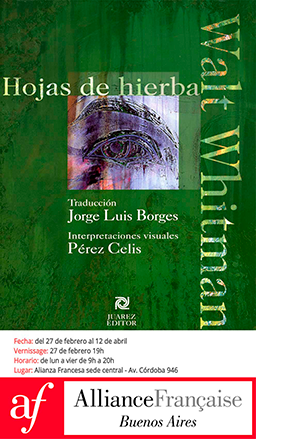THE LATIN AMERICAN GAZE IN ARCO’S “PROFILES” PROGRAM
ARCO continues to establish itself as one of the essential annual events for assessing, analyzing, and taking the pulse of the proposals that illustrate the strongest trends in contemporary Latin American art. In this pursuit, the fair remains committed to showcasing some of the most relevant projects through the eyes of experts via specific programs. Regarding this edition (let us not forget that curatorial presence is doubled thanks to the Watamisé program, focused on Amazonian art), the organization has entrusted Mexican curator José Esparza Chong Cuy with the development of Perfiles | Arte latinoamericano, a curated journey that highlights, through ten selected figures, the diversity of visual approaches. As the curator himself states, it offers "a broad panorama of how to identify as artists and build community, proposing new ways of making, thinking, and living together."
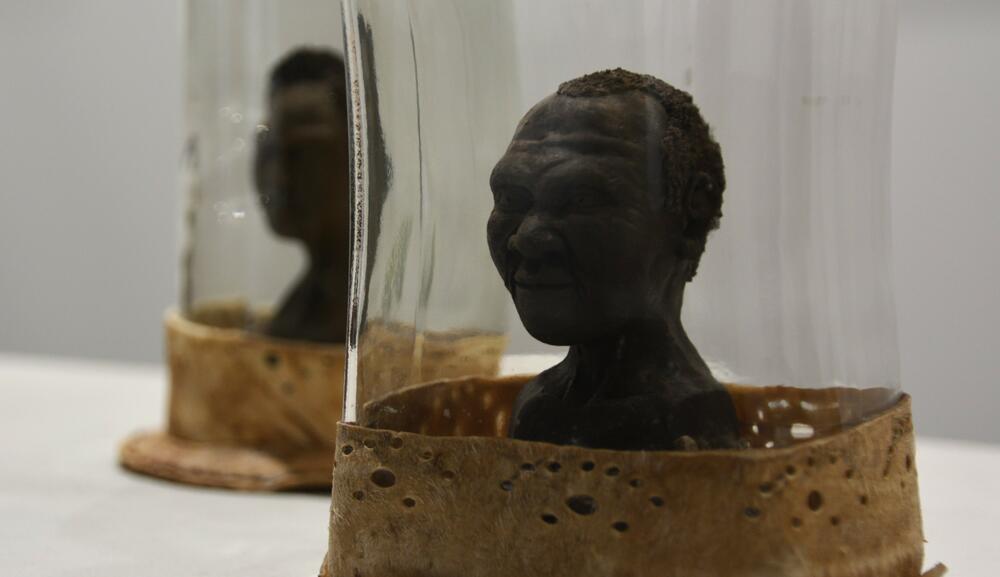
Diving into the spaces reserved for the program, the emphasis on diversity becomes evident—at least technically and visually—from the very first tour. Sertão Negro is the project presented by the Brazilian Cerrado Galeria. Created by artist Dalton Paula (Brasilia, Brazil, 1982), it also opens the space for collaboration with Abraão Veloso, Tor Teixeira, Lucélia Maciel, and Genor Sales, creating an educationally tinged environment aimed at defining and transforming social systems in alignment with local artist networks. This exhibition space stands out as the most distinct, perhaps due to its collective nature, moving away from a singular artistic identity. It materializes its objective through a range of works, from textiles to sculptures. In a similar vein, Mariela Scafati (Bahía Blanca, Argentina, 1973) presents at Isla Flotante a selection of paintings, sculptural pieces, and a mural composed of protest posters. Her aesthetics challenge traditional representations and propose new ways of seeing.
Barbara Wien showcases the work of Dan Lie (São Paulo, Brazil, 1988), whose practice is deeply connected to nature and sensory experiences. Focused on active engagement and direct interaction with viewers through scents and plant textures, Lie offers a necessary refuge for reflecting on the relationship between society, humanity, and the natural ecosystem. Similarly, Puerto Rican-German artist Chaveli Sifre (Würzburg, Germany, 1987) presents a project at Embajada that aligns with these themes. Her work revisits ancestral practices, tarot, and sensory experiences, intertwining olfaction and botany to reconstruct a universe that blends science, magic, and spirituality.
-
Rember Yahuarcani, CRISIS, Perfiles | Arte latinoamericano
-
Rember Yahuarcani, CRISIS, Perfiles | Arte latinoamericano
-
Jota Mombaça, Martins & Montero, Perfiles | Arte latinoamericano
-
Ofelia Rodríguez, Instituto de Visión, Perfiles | Arte latinoamericano
-
Naufus Ramirez Figueroa, Ultraviolet Projects, Perfiles | Arte latinoamericano
-
Lucélia Maziel-Sertão Negro, Cerrado Galeria, Perfiles | Arte latinoamericano
Agrade Camíz (Rio de Janeiro, Brazil, 1988), represented by A Gentil Carioca, creates a transliteration of architectural elements tied to the urban imagination of his hometown. His works explore, from a perspective of resistance, historical and social dynamics, as well as issues related to aesthetics and the oppression of women. This ongoing thematic focus on resistance is also central to the work of performance artist and writer Jota Mombaça (Natal, Brazil, 1991), showcased by Martins&Montero. Her proposal seeks to abolish the defining parameters of existing identity categories. Meanwhile, fashion designer Bárbara Sánchez-Kane (Mérida, Mexico, 1986) presents at kurimanzutto a foundation for developing a shared visual language between art and fashion, aiming to create new codes that embrace diversity and multiple identities.
Ofelia Rodríguez (Barranquilla, Colombia, 1946) offers, at Instituto de Visión, an intriguing pause in the discussion of social dynamics. While her symbolic objects and paintings engage with critiques of stereotypes and cultural practices, her work also breathes aesthetic refinement and composition, often returning to humor and—almost invariably—color as defining elements of her identity. Naufus Ramírez Figueroa (Guatemala City, Guatemala, 1978), who will soon have a solo exhibition at the Reina Sofía Museum, offers at Proyectos Ultravioleta a preview of his work. His paintings, installations, and sculptures address history and its collateral damages, advocating for spaces that allow for rethinking both the collective and the personal.
-
Agrade Camíz_A Gentil Carioca, Perfiles I Arte Latinoamericano
-
Agrade Camíz_A Gentil Carioca, Perfiles I Arte Latinoamericano
-
Barbara Sánchez-Kane, kurimanzutto, Perfiles I Arte latinoamericano
-
Dan Lie, Barbara Wien, Cerrado Galeria, Perfiles I Arte Latinoamericano
-
Mariela Scafati, Isla Flotante, Perfiles I Arte Latinoamericano
-
Chaveli Sifre, Embajada, Perfiles I Arte Latinoamericano
The work of Rember Yahuarcani (Pebas, Peru, 1985), presented at CRISIS, transports us to indigenous narratives that highlight the need to revisit traditional iconographies. His use of color hints at a futurist approach to visual language while remaining deeply rooted in pictorial traditions. Positioned within the broader Latin American art framework—yet spatially distinct from the Amazonian program—his work also underscores the importance of historiography in shaping new registers of Latin American art.
Perfiles | Arte latinoamericano takes place during ARCO Madrid 2025, from March 5 to 9, at Pavilion 9 of IFEMA, Partenón 5, Madrid, Spain.
Related Topics
May interest you
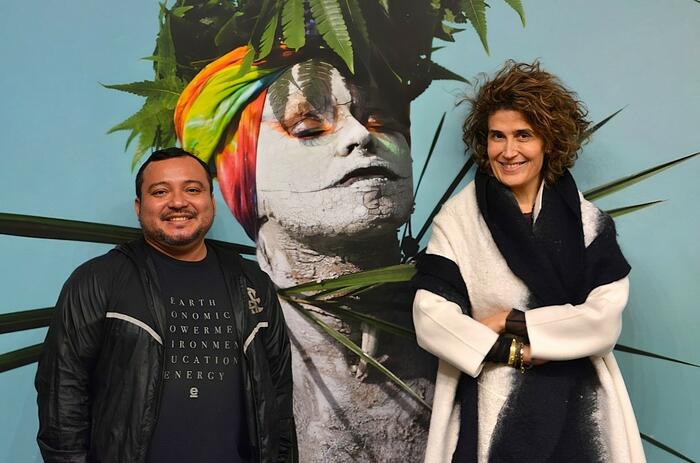
Maria Wills (Bogota, Colombia 1979) and Denilson Baniwa (Barcelos, Brazil, 1984) are the responsible for Wametisé: ideas for an amazofuturism, one of the special programs curated for ARCO 2025 and that navigates the Amazon and its growing impact on contemporary art. This proposal proposes a scenario of representation and dialogue through a selection of galleries and guest artists who will raise, through their works and their realities, the different conceptions of the Amazonian world and the possibilities of a collective future.
MARIA WILLS AND DENILSON BANIWA ON AMAZOFUTURISM
Maria Wills (Bogota, Colombia 1979) and Denilson Baniwa (Barcelos, Brazil, 1984) are the responsible for Wametisé: ideas for an amazofuturism, one of the special programs curated for ARCO 2025 and that navigates the Amazon and its growing impact on contemporary art. This proposal proposes a scenario of representation and dialogue through a selection of galleries and guest artists who will raise, through their works and their realities, the different conceptions of the Amazonian world and the possibilities of a collective future.

Maria Wills (Bogota, Colombia 1979) and Denilson Baniwa (Barcelos, Brazil, 1984) are the responsible for Wametisé: ideas for an amazofuturism, one of the special programs curated for ARCO 2025 and that navigates the Amazon and its growing impact on contemporary art. This proposal proposes a scenario of representation and dialogue through a selection of galleries and guest artists who will raise, through their works and their realities, the different conceptions of the Amazonian world and the possibilities of a collective future.
MARIA WILLS AND DENILSON BANIWA ON AMAZOFUTURISM
Maria Wills (Bogota, Colombia 1979) and Denilson Baniwa (Barcelos, Brazil, 1984) are the responsible for Wametisé: ideas for an amazofuturism, one of the special programs curated for ARCO 2025 and that navigates the Amazon and its growing impact on contemporary art. This proposal proposes a scenario of representation and dialogue through a selection of galleries and guest artists who will raise, through their works and their realities, the different conceptions of the Amazonian world and the possibilities of a collective future.
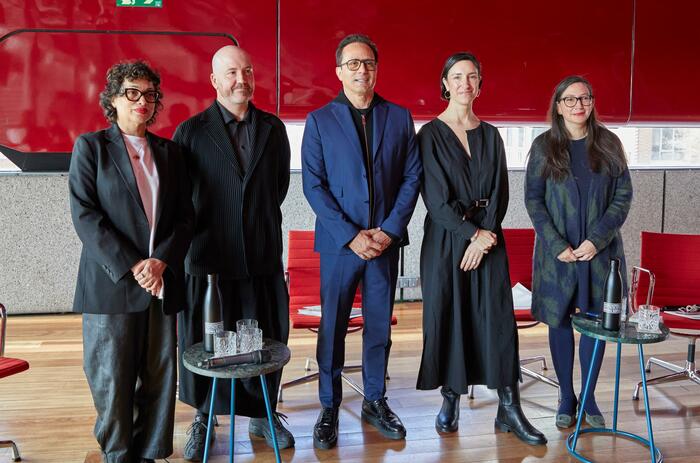
Madrid's Reina Sofia Museum, in collaboration with the Reina Sofia Museum Foundation, reinforces its growing involvement and strategy for the dissemination and study of Latin American contemporary art with the creation of the Cáder Institute of Central American Art (ICAC), dedicated to the research and dissemination of Central American art.
THE CENTRAL AMERICAN ART INSTITUTE (ICAC) OF THE REINA SOFIA MUSEUM IS BORN
Madrid's Reina Sofia Museum, in collaboration with the Reina Sofia Museum Foundation, reinforces its growing involvement and strategy for the dissemination and study of Latin American contemporary art with the creation of the Cáder Institute of Central American Art (ICAC), dedicated to the research and dissemination of Central American art.
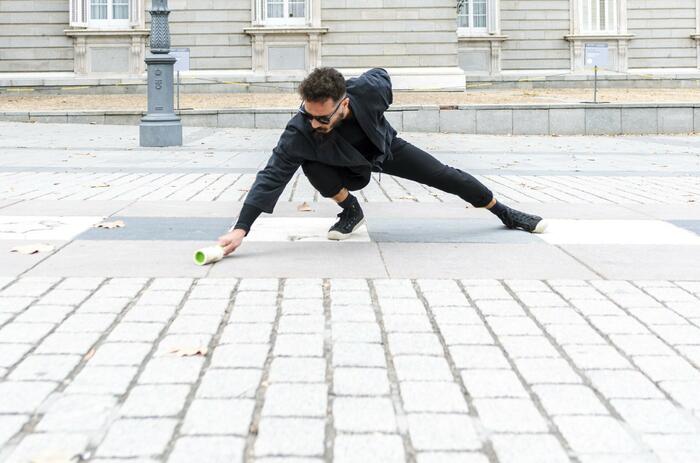
Intricate between action and register, El Apartamento hosts Algo deja quien se va, the first solo exhibition in Spain by Reynier Leyva Novo (Havana, Cuba, 1983). Starting from the political concept of historical memory and linking it to the issues of power and colonialism, the artist unfolds in two well-differentiated series his proposal to approach these lines, and extends his networks to the impact (or influence) they have on the institutional and cultural fabric.
LEYVA NOVO: DUST IT IS AND TO DUST IT WILL TURN
Intricate between action and register, El Apartamento hosts Algo deja quien se va, the first solo exhibition in Spain by Reynier Leyva Novo (Havana, Cuba, 1983). Starting from the political concept of historical memory and linking it to the issues of power and colonialism, the artist unfolds in two well-differentiated series his proposal to approach these lines, and extends his networks to the impact (or influence) they have on the institutional and cultural fabric.
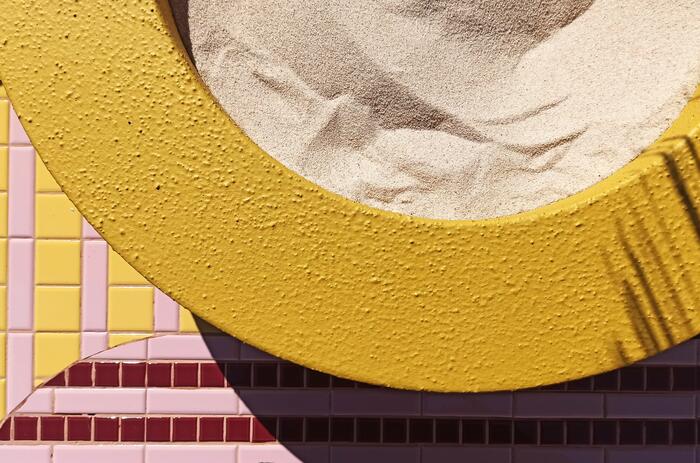
The intervention Wasi Llamkha (Place and touch), by artist Andrea Canepa (Lima, Peru, 1980), stands on the South Patio of Madrid's Condeduque. This pavilion, designed as an ephemeral architectural structure, invites us to explore its sensorial value, far from the preeminence of the visual, and claims, by way of inspiration, the quipus, the forms of representation and recording of information from pre-Columbian Peru.
SPACE AND SENSES IN ANDREA CANEPA
The intervention Wasi Llamkha (Place and touch), by artist Andrea Canepa (Lima, Peru, 1980), stands on the South Patio of Madrid's Condeduque. This pavilion, designed as an ephemeral architectural structure, invites us to explore its sensorial value, far from the preeminence of the visual, and claims, by way of inspiration, the quipus, the forms of representation and recording of information from pre-Columbian Peru.
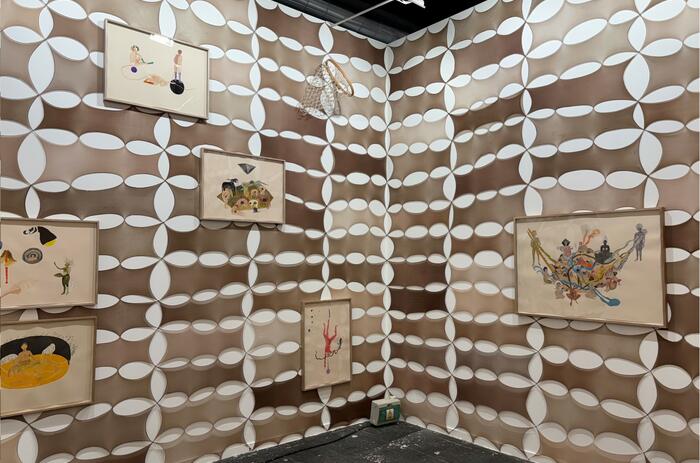
The Museo Nacional Centro de Arte Reina Sofía has announced the acquisitions made during the ARCO fair, through which both the institution and the Ministry of Culture expand the museum’s collections. Among the artists whose work is now part of the Madrid-based institution are Argentine artist Marta Minujín and Colombian artists Juan Pablo Echeverri and Luz Lizarazo—three figures with different career trajectories who bring a distinct Latin American perspective to a list of acquisitions largely focused on Spanish artists.
THE REINA SOFÍA ACQUIRES WORKS BY MINUJÍN, LIZARAZO AND ECHEVERRI AT ARCO FOR ITS COLLECTION
The Museo Nacional Centro de Arte Reina Sofía has announced the acquisitions made during the ARCO fair, through which both the institution and the Ministry of Culture expand the museum’s collections. Among the artists whose work is now part of the Madrid-based institution are Argentine artist Marta Minujín and Colombian artists Juan Pablo Echeverri and Luz Lizarazo—three figures with different career trajectories who bring a distinct Latin American perspective to a list of acquisitions largely focused on Spanish artists.
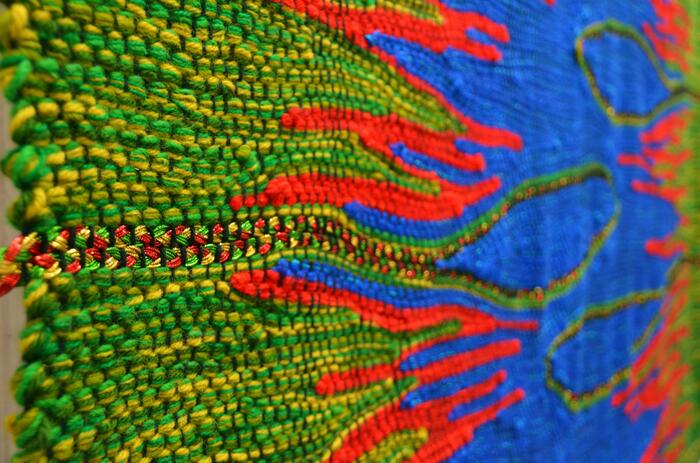
The Latin American presence at ARCO is consolidating year after year, establishing itself as a primary guiding thread beyond market trends, becoming a significant part of the identity of the Madrid fair. In this sense, the participating galleries in the various programs showcase well-established names as well as younger or more radical bets, shaping an ecosystem in which various productions can be analyzed.
ARCO 2025: DIFFERENT VIEWS ON LATIN AMERICA
The Latin American presence at ARCO is consolidating year after year, establishing itself as a primary guiding thread beyond market trends, becoming a significant part of the identity of the Madrid fair. In this sense, the participating galleries in the various programs showcase well-established names as well as younger or more radical bets, shaping an ecosystem in which various productions can be analyzed.
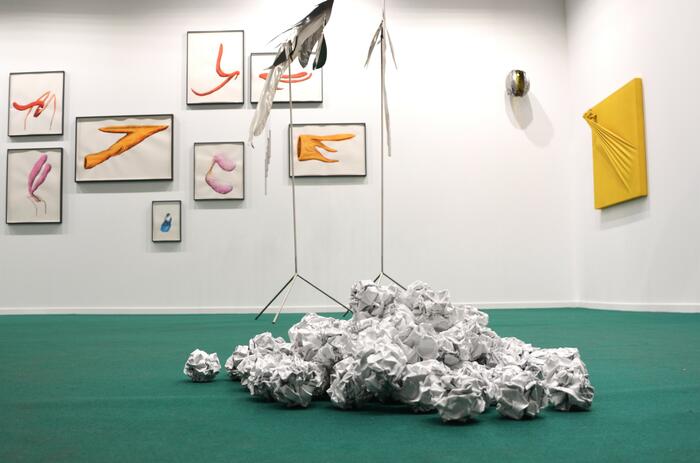
With strong gallery participation, ARCO is an interesting point to measure how the proposals reach the visitor and the collector. The choices based on aesthetic or commercial criteria create synergies that shape a fluid and sometimes circumstantial representation of each catalog. From Arte al Día, we delve into ten of those catalogs, expanded to variegated universes, monographs and dialogues that show a sample of the approach of Latin American galleries in their presence at the Madrid fair.
THE UNIVERSES OF THE LATIN AMERICAN GALLERIES IN ARCO
With strong gallery participation, ARCO is an interesting point to measure how the proposals reach the visitor and the collector. The choices based on aesthetic or commercial criteria create synergies that shape a fluid and sometimes circumstantial representation of each catalog. From Arte al Día, we delve into ten of those catalogs, expanded to variegated universes, monographs and dialogues that show a sample of the approach of Latin American galleries in their presence at the Madrid fair.
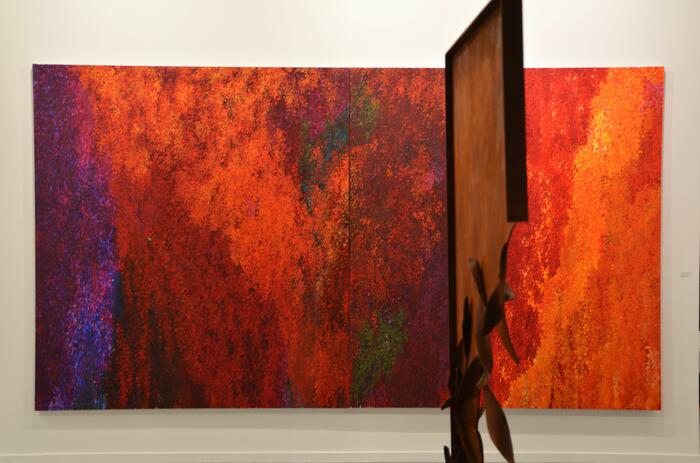
ARCOmadrid 2025 comes to an end with almost as many answers as questions. On the one hand, the concept of the fair—its commercial dimension—is now firmly established, marking a shift from the situation of a few years ago, when ARCO’s role as a meeting point for the general public seemed essential. This does not mean that attracting an audience with access to contemporary art is no longer part of its strategy, but rather that the fair now operates with a dual focus on two clearly defined lines of work: what and how. This shift consolidates the growing emphasis on collectors and institutions.
A CRITICAL OVERVIEW AT ARCO 2025
ARCOmadrid 2025 comes to an end with almost as many answers as questions. On the one hand, the concept of the fair—its commercial dimension—is now firmly established, marking a shift from the situation of a few years ago, when ARCO’s role as a meeting point for the general public seemed essential. This does not mean that attracting an audience with access to contemporary art is no longer part of its strategy, but rather that the fair now operates with a dual focus on two clearly defined lines of work: what and how. This shift consolidates the growing emphasis on collectors and institutions.

The Museum of Modern Art of Bogota (MAMBO) presents its first exhibition cycle of 2025 with Colombian artist Julieth Morales, Chilean artist Seba Calfuqueo, and Brazilian artist UÝRA. They address, from different perspectives, the relationship between identity, territory and memory, proposing new forms of resistance.
THREE ARTISTS QUESTIONING OFFICIAL NARRATIVES AT MAMBO
The Museum of Modern Art of Bogota (MAMBO) presents its first exhibition cycle of 2025 with Colombian artist Julieth Morales, Chilean artist Seba Calfuqueo, and Brazilian artist UÝRA. They address, from different perspectives, the relationship between identity, territory and memory, proposing new forms of resistance.

The Museo La Neomudéjar presents No hay más ciego que el que no quiere ver (No one is more blind than the one who refuses to see), a solo exhibition by Marisa Caichiolo (Santa Fe, Argentina, 1974). In this project, the artist explores and materializes pain and absence, primarily through embroidery. Drawing from her personal experiences, Caichiolo constructs narratives of resistance and instrumental memory to confront traumatic episodes—many of them rooted in forced disappearances.
THE SUBTLE EMBROIDERY OF PAIN BY MARISA CAICHIOLO AT LNM MUSEUM
The Museo La Neomudéjar presents No hay más ciego que el que no quiere ver (No one is more blind than the one who refuses to see), a solo exhibition by Marisa Caichiolo (Santa Fe, Argentina, 1974). In this project, the artist explores and materializes pain and absence, primarily through embroidery. Drawing from her personal experiences, Caichiolo constructs narratives of resistance and instrumental memory to confront traumatic episodes—many of them rooted in forced disappearances.
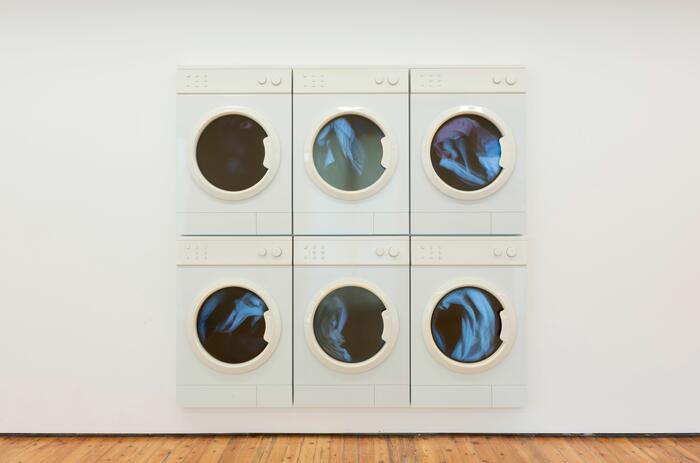
La nevera en la sala (The Fridge in the Living Room) is the arrangement through which Leandro Erlich (Buenos Aires, Argentina, 1973) reinterprets his vision of perception through architecture and everyday life at Prats Nogueras Blanchard. A recurring theme in this Argentine artist’s work, the pieces exhibited at the gallery’s Madrid headquarters do not belong to a new production but rather mark the first public presentation of a series of works that engage with realism and illusion, complemented by their location and functionality within the space.
PERCEPTION AND QUOTIDIANITY IN LEANDRO ERLICH
La nevera en la sala (The Fridge in the Living Room) is the arrangement through which Leandro Erlich (Buenos Aires, Argentina, 1973) reinterprets his vision of perception through architecture and everyday life at Prats Nogueras Blanchard. A recurring theme in this Argentine artist’s work, the pieces exhibited at the gallery’s Madrid headquarters do not belong to a new production but rather mark the first public presentation of a series of works that engage with realism and illusion, complemented by their location and functionality within the space.
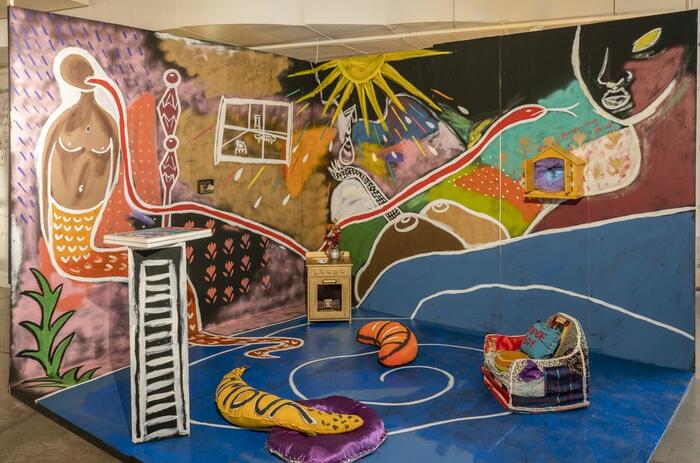
For 66 days, the exhibition will spread throughout the city, bringing together works by 76 artists from different regions of the world, focusing on exchanges between various social contexts and artistic languages as a way to explore the multiplicity of experiences between art and life.
THE 14TH MERCOSUR BIENNIAL: A CELEBRATION OF ARTISTIC DIVERSITY
For 66 days, the exhibition will spread throughout the city, bringing together works by 76 artists from different regions of the world, focusing on exchanges between various social contexts and artistic languages as a way to explore the multiplicity of experiences between art and life.
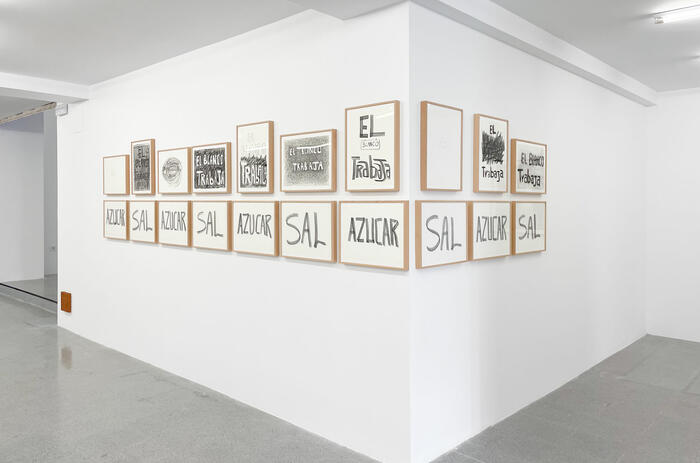
The concern about how the surrounding affects not only the individual but also artistic production connects with the principle by which Édgar Calel (San Juan Comalapa, Guatemala, 1987) has developed a unique project from scratch at La Oficina gallery. Sueños guardados en granos de maíz brings us to a specific moment of materialization, but it expands toward all the vertices with which the artist works, delving above all into the importance of ancestry, identity, and the spirituality that is related to space.
TRADITION, IDENTITY AND CONTEMPORARY LANGUAGE IN ÉDGAR CALEL
The concern about how the surrounding affects not only the individual but also artistic production connects with the principle by which Édgar Calel (San Juan Comalapa, Guatemala, 1987) has developed a unique project from scratch at La Oficina gallery. Sueños guardados en granos de maíz brings us to a specific moment of materialization, but it expands toward all the vertices with which the artist works, delving above all into the importance of ancestry, identity, and the spirituality that is related to space.
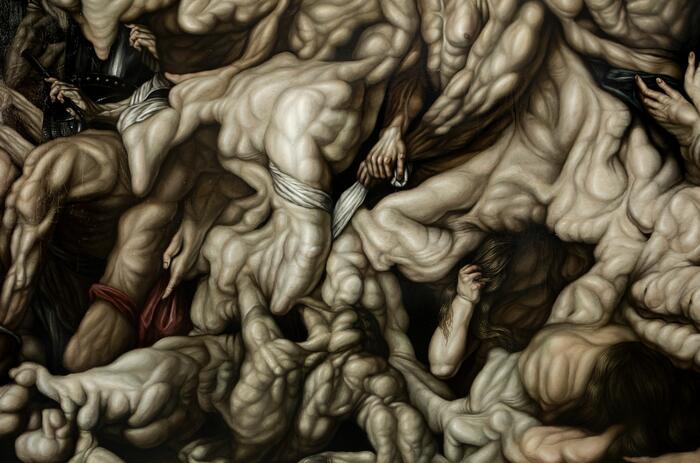
The renowned artist Moico Yaker returns to the exhibition halls with a solo show after six years to present Conversaciones en el zoológico (Conversations at the Zoo), while Rafael Pascuale explores the relationship between the body and fragility in Espejos de una humanidad perdida (Mirrors of a Lost Humanity).
MAC LIMA LAUNCHES ITS CYCLE OF TEMPORARY EXHIBITIONS
The renowned artist Moico Yaker returns to the exhibition halls with a solo show after six years to present Conversaciones en el zoológico (Conversations at the Zoo), while Rafael Pascuale explores the relationship between the body and fragility in Espejos de una humanidad perdida (Mirrors of a Lost Humanity).
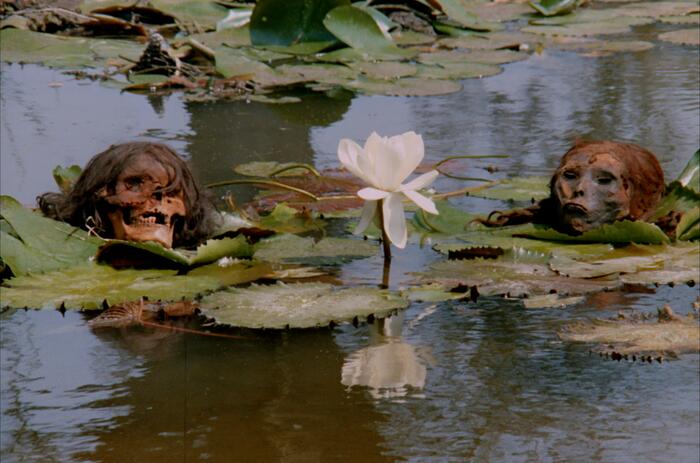
The exhibition El incondicionado desocultamiento: las experimentaciones audiovisuales de Rafael Hastings (The Unconditioned Unveiling: Rafael Hastings’ Audiovisual Experimentations) has opened at the ICPNA San Miguel space, offering a revisit of the Peruvian visual artist’s filmic work.
A REVISIT TO THE WORK OF RAPHAEL HASTINGS AT ICPNA
The exhibition El incondicionado desocultamiento: las experimentaciones audiovisuales de Rafael Hastings (The Unconditioned Unveiling: Rafael Hastings’ Audiovisual Experimentations) has opened at the ICPNA San Miguel space, offering a revisit of the Peruvian visual artist’s filmic work.

Maria Wills (Bogota, Colombia 1979) and Denilson Baniwa (Barcelos, Brazil, 1984) are the responsible for Wametisé: ideas for an amazofuturism, one of the special programs curated for ARCO 2025 and that navigates the Amazon and its growing impact on contemporary art. This proposal proposes a scenario of representation and dialogue through a selection of galleries and guest artists who will raise, through their works and their realities, the different conceptions of the Amazonian world and the possibilities of a collective future.
MARIA WILLS AND DENILSON BANIWA ON AMAZOFUTURISM
Maria Wills (Bogota, Colombia 1979) and Denilson Baniwa (Barcelos, Brazil, 1984) are the responsible for Wametisé: ideas for an amazofuturism, one of the special programs curated for ARCO 2025 and that navigates the Amazon and its growing impact on contemporary art. This proposal proposes a scenario of representation and dialogue through a selection of galleries and guest artists who will raise, through their works and their realities, the different conceptions of the Amazonian world and the possibilities of a collective future.

Madrid's Reina Sofia Museum, in collaboration with the Reina Sofia Museum Foundation, reinforces its growing involvement and strategy for the dissemination and study of Latin American contemporary art with the creation of the Cáder Institute of Central American Art (ICAC), dedicated to the research and dissemination of Central American art.
THE CENTRAL AMERICAN ART INSTITUTE (ICAC) OF THE REINA SOFIA MUSEUM IS BORN
Madrid's Reina Sofia Museum, in collaboration with the Reina Sofia Museum Foundation, reinforces its growing involvement and strategy for the dissemination and study of Latin American contemporary art with the creation of the Cáder Institute of Central American Art (ICAC), dedicated to the research and dissemination of Central American art.

Intricate between action and register, El Apartamento hosts Algo deja quien se va, the first solo exhibition in Spain by Reynier Leyva Novo (Havana, Cuba, 1983). Starting from the political concept of historical memory and linking it to the issues of power and colonialism, the artist unfolds in two well-differentiated series his proposal to approach these lines, and extends his networks to the impact (or influence) they have on the institutional and cultural fabric.
LEYVA NOVO: DUST IT IS AND TO DUST IT WILL TURN
Intricate between action and register, El Apartamento hosts Algo deja quien se va, the first solo exhibition in Spain by Reynier Leyva Novo (Havana, Cuba, 1983). Starting from the political concept of historical memory and linking it to the issues of power and colonialism, the artist unfolds in two well-differentiated series his proposal to approach these lines, and extends his networks to the impact (or influence) they have on the institutional and cultural fabric.

The intervention Wasi Llamkha (Place and touch), by artist Andrea Canepa (Lima, Peru, 1980), stands on the South Patio of Madrid's Condeduque. This pavilion, designed as an ephemeral architectural structure, invites us to explore its sensorial value, far from the preeminence of the visual, and claims, by way of inspiration, the quipus, the forms of representation and recording of information from pre-Columbian Peru.
SPACE AND SENSES IN ANDREA CANEPA
The intervention Wasi Llamkha (Place and touch), by artist Andrea Canepa (Lima, Peru, 1980), stands on the South Patio of Madrid's Condeduque. This pavilion, designed as an ephemeral architectural structure, invites us to explore its sensorial value, far from the preeminence of the visual, and claims, by way of inspiration, the quipus, the forms of representation and recording of information from pre-Columbian Peru.

The Museo Nacional Centro de Arte Reina Sofía has announced the acquisitions made during the ARCO fair, through which both the institution and the Ministry of Culture expand the museum’s collections. Among the artists whose work is now part of the Madrid-based institution are Argentine artist Marta Minujín and Colombian artists Juan Pablo Echeverri and Luz Lizarazo—three figures with different career trajectories who bring a distinct Latin American perspective to a list of acquisitions largely focused on Spanish artists.
THE REINA SOFÍA ACQUIRES WORKS BY MINUJÍN, LIZARAZO AND ECHEVERRI AT ARCO FOR ITS COLLECTION
The Museo Nacional Centro de Arte Reina Sofía has announced the acquisitions made during the ARCO fair, through which both the institution and the Ministry of Culture expand the museum’s collections. Among the artists whose work is now part of the Madrid-based institution are Argentine artist Marta Minujín and Colombian artists Juan Pablo Echeverri and Luz Lizarazo—three figures with different career trajectories who bring a distinct Latin American perspective to a list of acquisitions largely focused on Spanish artists.

The Latin American presence at ARCO is consolidating year after year, establishing itself as a primary guiding thread beyond market trends, becoming a significant part of the identity of the Madrid fair. In this sense, the participating galleries in the various programs showcase well-established names as well as younger or more radical bets, shaping an ecosystem in which various productions can be analyzed.
ARCO 2025: DIFFERENT VIEWS ON LATIN AMERICA
The Latin American presence at ARCO is consolidating year after year, establishing itself as a primary guiding thread beyond market trends, becoming a significant part of the identity of the Madrid fair. In this sense, the participating galleries in the various programs showcase well-established names as well as younger or more radical bets, shaping an ecosystem in which various productions can be analyzed.

With strong gallery participation, ARCO is an interesting point to measure how the proposals reach the visitor and the collector. The choices based on aesthetic or commercial criteria create synergies that shape a fluid and sometimes circumstantial representation of each catalog. From Arte al Día, we delve into ten of those catalogs, expanded to variegated universes, monographs and dialogues that show a sample of the approach of Latin American galleries in their presence at the Madrid fair.
THE UNIVERSES OF THE LATIN AMERICAN GALLERIES IN ARCO
With strong gallery participation, ARCO is an interesting point to measure how the proposals reach the visitor and the collector. The choices based on aesthetic or commercial criteria create synergies that shape a fluid and sometimes circumstantial representation of each catalog. From Arte al Día, we delve into ten of those catalogs, expanded to variegated universes, monographs and dialogues that show a sample of the approach of Latin American galleries in their presence at the Madrid fair.

ARCOmadrid 2025 comes to an end with almost as many answers as questions. On the one hand, the concept of the fair—its commercial dimension—is now firmly established, marking a shift from the situation of a few years ago, when ARCO’s role as a meeting point for the general public seemed essential. This does not mean that attracting an audience with access to contemporary art is no longer part of its strategy, but rather that the fair now operates with a dual focus on two clearly defined lines of work: what and how. This shift consolidates the growing emphasis on collectors and institutions.
A CRITICAL OVERVIEW AT ARCO 2025
ARCOmadrid 2025 comes to an end with almost as many answers as questions. On the one hand, the concept of the fair—its commercial dimension—is now firmly established, marking a shift from the situation of a few years ago, when ARCO’s role as a meeting point for the general public seemed essential. This does not mean that attracting an audience with access to contemporary art is no longer part of its strategy, but rather that the fair now operates with a dual focus on two clearly defined lines of work: what and how. This shift consolidates the growing emphasis on collectors and institutions.

The Museum of Modern Art of Bogota (MAMBO) presents its first exhibition cycle of 2025 with Colombian artist Julieth Morales, Chilean artist Seba Calfuqueo, and Brazilian artist UÝRA. They address, from different perspectives, the relationship between identity, territory and memory, proposing new forms of resistance.
THREE ARTISTS QUESTIONING OFFICIAL NARRATIVES AT MAMBO
The Museum of Modern Art of Bogota (MAMBO) presents its first exhibition cycle of 2025 with Colombian artist Julieth Morales, Chilean artist Seba Calfuqueo, and Brazilian artist UÝRA. They address, from different perspectives, the relationship between identity, territory and memory, proposing new forms of resistance.

The Museo La Neomudéjar presents No hay más ciego que el que no quiere ver (No one is more blind than the one who refuses to see), a solo exhibition by Marisa Caichiolo (Santa Fe, Argentina, 1974). In this project, the artist explores and materializes pain and absence, primarily through embroidery. Drawing from her personal experiences, Caichiolo constructs narratives of resistance and instrumental memory to confront traumatic episodes—many of them rooted in forced disappearances.
THE SUBTLE EMBROIDERY OF PAIN BY MARISA CAICHIOLO AT LNM MUSEUM
The Museo La Neomudéjar presents No hay más ciego que el que no quiere ver (No one is more blind than the one who refuses to see), a solo exhibition by Marisa Caichiolo (Santa Fe, Argentina, 1974). In this project, the artist explores and materializes pain and absence, primarily through embroidery. Drawing from her personal experiences, Caichiolo constructs narratives of resistance and instrumental memory to confront traumatic episodes—many of them rooted in forced disappearances.

La nevera en la sala (The Fridge in the Living Room) is the arrangement through which Leandro Erlich (Buenos Aires, Argentina, 1973) reinterprets his vision of perception through architecture and everyday life at Prats Nogueras Blanchard. A recurring theme in this Argentine artist’s work, the pieces exhibited at the gallery’s Madrid headquarters do not belong to a new production but rather mark the first public presentation of a series of works that engage with realism and illusion, complemented by their location and functionality within the space.
PERCEPTION AND QUOTIDIANITY IN LEANDRO ERLICH
La nevera en la sala (The Fridge in the Living Room) is the arrangement through which Leandro Erlich (Buenos Aires, Argentina, 1973) reinterprets his vision of perception through architecture and everyday life at Prats Nogueras Blanchard. A recurring theme in this Argentine artist’s work, the pieces exhibited at the gallery’s Madrid headquarters do not belong to a new production but rather mark the first public presentation of a series of works that engage with realism and illusion, complemented by their location and functionality within the space.

For 66 days, the exhibition will spread throughout the city, bringing together works by 76 artists from different regions of the world, focusing on exchanges between various social contexts and artistic languages as a way to explore the multiplicity of experiences between art and life.
THE 14TH MERCOSUR BIENNIAL: A CELEBRATION OF ARTISTIC DIVERSITY
For 66 days, the exhibition will spread throughout the city, bringing together works by 76 artists from different regions of the world, focusing on exchanges between various social contexts and artistic languages as a way to explore the multiplicity of experiences between art and life.

The concern about how the surrounding affects not only the individual but also artistic production connects with the principle by which Édgar Calel (San Juan Comalapa, Guatemala, 1987) has developed a unique project from scratch at La Oficina gallery. Sueños guardados en granos de maíz brings us to a specific moment of materialization, but it expands toward all the vertices with which the artist works, delving above all into the importance of ancestry, identity, and the spirituality that is related to space.
TRADITION, IDENTITY AND CONTEMPORARY LANGUAGE IN ÉDGAR CALEL
The concern about how the surrounding affects not only the individual but also artistic production connects with the principle by which Édgar Calel (San Juan Comalapa, Guatemala, 1987) has developed a unique project from scratch at La Oficina gallery. Sueños guardados en granos de maíz brings us to a specific moment of materialization, but it expands toward all the vertices with which the artist works, delving above all into the importance of ancestry, identity, and the spirituality that is related to space.

The renowned artist Moico Yaker returns to the exhibition halls with a solo show after six years to present Conversaciones en el zoológico (Conversations at the Zoo), while Rafael Pascuale explores the relationship between the body and fragility in Espejos de una humanidad perdida (Mirrors of a Lost Humanity).
MAC LIMA LAUNCHES ITS CYCLE OF TEMPORARY EXHIBITIONS
The renowned artist Moico Yaker returns to the exhibition halls with a solo show after six years to present Conversaciones en el zoológico (Conversations at the Zoo), while Rafael Pascuale explores the relationship between the body and fragility in Espejos de una humanidad perdida (Mirrors of a Lost Humanity).

The exhibition El incondicionado desocultamiento: las experimentaciones audiovisuales de Rafael Hastings (The Unconditioned Unveiling: Rafael Hastings’ Audiovisual Experimentations) has opened at the ICPNA San Miguel space, offering a revisit of the Peruvian visual artist’s filmic work.
A REVISIT TO THE WORK OF RAPHAEL HASTINGS AT ICPNA
The exhibition El incondicionado desocultamiento: las experimentaciones audiovisuales de Rafael Hastings (The Unconditioned Unveiling: Rafael Hastings’ Audiovisual Experimentations) has opened at the ICPNA San Miguel space, offering a revisit of the Peruvian visual artist’s filmic work.

Maria Wills (Bogota, Colombia 1979) and Denilson Baniwa (Barcelos, Brazil, 1984) are the responsible for Wametisé: ideas for an amazofuturism, one of the special programs curated for ARCO 2025 and that navigates the Amazon and its growing impact on contemporary art. This proposal proposes a scenario of representation and dialogue through a selection of galleries and guest artists who will raise, through their works and their realities, the different conceptions of the Amazonian world and the possibilities of a collective future.
MARIA WILLS AND DENILSON BANIWA ON AMAZOFUTURISM
Maria Wills (Bogota, Colombia 1979) and Denilson Baniwa (Barcelos, Brazil, 1984) are the responsible for Wametisé: ideas for an amazofuturism, one of the special programs curated for ARCO 2025 and that navigates the Amazon and its growing impact on contemporary art. This proposal proposes a scenario of representation and dialogue through a selection of galleries and guest artists who will raise, through their works and their realities, the different conceptions of the Amazonian world and the possibilities of a collective future.

Madrid's Reina Sofia Museum, in collaboration with the Reina Sofia Museum Foundation, reinforces its growing involvement and strategy for the dissemination and study of Latin American contemporary art with the creation of the Cáder Institute of Central American Art (ICAC), dedicated to the research and dissemination of Central American art.
THE CENTRAL AMERICAN ART INSTITUTE (ICAC) OF THE REINA SOFIA MUSEUM IS BORN
Madrid's Reina Sofia Museum, in collaboration with the Reina Sofia Museum Foundation, reinforces its growing involvement and strategy for the dissemination and study of Latin American contemporary art with the creation of the Cáder Institute of Central American Art (ICAC), dedicated to the research and dissemination of Central American art.

Intricate between action and register, El Apartamento hosts Algo deja quien se va, the first solo exhibition in Spain by Reynier Leyva Novo (Havana, Cuba, 1983). Starting from the political concept of historical memory and linking it to the issues of power and colonialism, the artist unfolds in two well-differentiated series his proposal to approach these lines, and extends his networks to the impact (or influence) they have on the institutional and cultural fabric.
LEYVA NOVO: DUST IT IS AND TO DUST IT WILL TURN
Intricate between action and register, El Apartamento hosts Algo deja quien se va, the first solo exhibition in Spain by Reynier Leyva Novo (Havana, Cuba, 1983). Starting from the political concept of historical memory and linking it to the issues of power and colonialism, the artist unfolds in two well-differentiated series his proposal to approach these lines, and extends his networks to the impact (or influence) they have on the institutional and cultural fabric.

The intervention Wasi Llamkha (Place and touch), by artist Andrea Canepa (Lima, Peru, 1980), stands on the South Patio of Madrid's Condeduque. This pavilion, designed as an ephemeral architectural structure, invites us to explore its sensorial value, far from the preeminence of the visual, and claims, by way of inspiration, the quipus, the forms of representation and recording of information from pre-Columbian Peru.
SPACE AND SENSES IN ANDREA CANEPA
The intervention Wasi Llamkha (Place and touch), by artist Andrea Canepa (Lima, Peru, 1980), stands on the South Patio of Madrid's Condeduque. This pavilion, designed as an ephemeral architectural structure, invites us to explore its sensorial value, far from the preeminence of the visual, and claims, by way of inspiration, the quipus, the forms of representation and recording of information from pre-Columbian Peru.

The Museo Nacional Centro de Arte Reina Sofía has announced the acquisitions made during the ARCO fair, through which both the institution and the Ministry of Culture expand the museum’s collections. Among the artists whose work is now part of the Madrid-based institution are Argentine artist Marta Minujín and Colombian artists Juan Pablo Echeverri and Luz Lizarazo—three figures with different career trajectories who bring a distinct Latin American perspective to a list of acquisitions largely focused on Spanish artists.
THE REINA SOFÍA ACQUIRES WORKS BY MINUJÍN, LIZARAZO AND ECHEVERRI AT ARCO FOR ITS COLLECTION
The Museo Nacional Centro de Arte Reina Sofía has announced the acquisitions made during the ARCO fair, through which both the institution and the Ministry of Culture expand the museum’s collections. Among the artists whose work is now part of the Madrid-based institution are Argentine artist Marta Minujín and Colombian artists Juan Pablo Echeverri and Luz Lizarazo—three figures with different career trajectories who bring a distinct Latin American perspective to a list of acquisitions largely focused on Spanish artists.

The Latin American presence at ARCO is consolidating year after year, establishing itself as a primary guiding thread beyond market trends, becoming a significant part of the identity of the Madrid fair. In this sense, the participating galleries in the various programs showcase well-established names as well as younger or more radical bets, shaping an ecosystem in which various productions can be analyzed.
ARCO 2025: DIFFERENT VIEWS ON LATIN AMERICA
The Latin American presence at ARCO is consolidating year after year, establishing itself as a primary guiding thread beyond market trends, becoming a significant part of the identity of the Madrid fair. In this sense, the participating galleries in the various programs showcase well-established names as well as younger or more radical bets, shaping an ecosystem in which various productions can be analyzed.

With strong gallery participation, ARCO is an interesting point to measure how the proposals reach the visitor and the collector. The choices based on aesthetic or commercial criteria create synergies that shape a fluid and sometimes circumstantial representation of each catalog. From Arte al Día, we delve into ten of those catalogs, expanded to variegated universes, monographs and dialogues that show a sample of the approach of Latin American galleries in their presence at the Madrid fair.
THE UNIVERSES OF THE LATIN AMERICAN GALLERIES IN ARCO
With strong gallery participation, ARCO is an interesting point to measure how the proposals reach the visitor and the collector. The choices based on aesthetic or commercial criteria create synergies that shape a fluid and sometimes circumstantial representation of each catalog. From Arte al Día, we delve into ten of those catalogs, expanded to variegated universes, monographs and dialogues that show a sample of the approach of Latin American galleries in their presence at the Madrid fair.

ARCOmadrid 2025 comes to an end with almost as many answers as questions. On the one hand, the concept of the fair—its commercial dimension—is now firmly established, marking a shift from the situation of a few years ago, when ARCO’s role as a meeting point for the general public seemed essential. This does not mean that attracting an audience with access to contemporary art is no longer part of its strategy, but rather that the fair now operates with a dual focus on two clearly defined lines of work: what and how. This shift consolidates the growing emphasis on collectors and institutions.
A CRITICAL OVERVIEW AT ARCO 2025
ARCOmadrid 2025 comes to an end with almost as many answers as questions. On the one hand, the concept of the fair—its commercial dimension—is now firmly established, marking a shift from the situation of a few years ago, when ARCO’s role as a meeting point for the general public seemed essential. This does not mean that attracting an audience with access to contemporary art is no longer part of its strategy, but rather that the fair now operates with a dual focus on two clearly defined lines of work: what and how. This shift consolidates the growing emphasis on collectors and institutions.

The Museum of Modern Art of Bogota (MAMBO) presents its first exhibition cycle of 2025 with Colombian artist Julieth Morales, Chilean artist Seba Calfuqueo, and Brazilian artist UÝRA. They address, from different perspectives, the relationship between identity, territory and memory, proposing new forms of resistance.
THREE ARTISTS QUESTIONING OFFICIAL NARRATIVES AT MAMBO
The Museum of Modern Art of Bogota (MAMBO) presents its first exhibition cycle of 2025 with Colombian artist Julieth Morales, Chilean artist Seba Calfuqueo, and Brazilian artist UÝRA. They address, from different perspectives, the relationship between identity, territory and memory, proposing new forms of resistance.

The Museo La Neomudéjar presents No hay más ciego que el que no quiere ver (No one is more blind than the one who refuses to see), a solo exhibition by Marisa Caichiolo (Santa Fe, Argentina, 1974). In this project, the artist explores and materializes pain and absence, primarily through embroidery. Drawing from her personal experiences, Caichiolo constructs narratives of resistance and instrumental memory to confront traumatic episodes—many of them rooted in forced disappearances.
THE SUBTLE EMBROIDERY OF PAIN BY MARISA CAICHIOLO AT LNM MUSEUM
The Museo La Neomudéjar presents No hay más ciego que el que no quiere ver (No one is more blind than the one who refuses to see), a solo exhibition by Marisa Caichiolo (Santa Fe, Argentina, 1974). In this project, the artist explores and materializes pain and absence, primarily through embroidery. Drawing from her personal experiences, Caichiolo constructs narratives of resistance and instrumental memory to confront traumatic episodes—many of them rooted in forced disappearances.

La nevera en la sala (The Fridge in the Living Room) is the arrangement through which Leandro Erlich (Buenos Aires, Argentina, 1973) reinterprets his vision of perception through architecture and everyday life at Prats Nogueras Blanchard. A recurring theme in this Argentine artist’s work, the pieces exhibited at the gallery’s Madrid headquarters do not belong to a new production but rather mark the first public presentation of a series of works that engage with realism and illusion, complemented by their location and functionality within the space.
PERCEPTION AND QUOTIDIANITY IN LEANDRO ERLICH
La nevera en la sala (The Fridge in the Living Room) is the arrangement through which Leandro Erlich (Buenos Aires, Argentina, 1973) reinterprets his vision of perception through architecture and everyday life at Prats Nogueras Blanchard. A recurring theme in this Argentine artist’s work, the pieces exhibited at the gallery’s Madrid headquarters do not belong to a new production but rather mark the first public presentation of a series of works that engage with realism and illusion, complemented by their location and functionality within the space.

For 66 days, the exhibition will spread throughout the city, bringing together works by 76 artists from different regions of the world, focusing on exchanges between various social contexts and artistic languages as a way to explore the multiplicity of experiences between art and life.
THE 14TH MERCOSUR BIENNIAL: A CELEBRATION OF ARTISTIC DIVERSITY
For 66 days, the exhibition will spread throughout the city, bringing together works by 76 artists from different regions of the world, focusing on exchanges between various social contexts and artistic languages as a way to explore the multiplicity of experiences between art and life.

The concern about how the surrounding affects not only the individual but also artistic production connects with the principle by which Édgar Calel (San Juan Comalapa, Guatemala, 1987) has developed a unique project from scratch at La Oficina gallery. Sueños guardados en granos de maíz brings us to a specific moment of materialization, but it expands toward all the vertices with which the artist works, delving above all into the importance of ancestry, identity, and the spirituality that is related to space.
TRADITION, IDENTITY AND CONTEMPORARY LANGUAGE IN ÉDGAR CALEL
The concern about how the surrounding affects not only the individual but also artistic production connects with the principle by which Édgar Calel (San Juan Comalapa, Guatemala, 1987) has developed a unique project from scratch at La Oficina gallery. Sueños guardados en granos de maíz brings us to a specific moment of materialization, but it expands toward all the vertices with which the artist works, delving above all into the importance of ancestry, identity, and the spirituality that is related to space.

The renowned artist Moico Yaker returns to the exhibition halls with a solo show after six years to present Conversaciones en el zoológico (Conversations at the Zoo), while Rafael Pascuale explores the relationship between the body and fragility in Espejos de una humanidad perdida (Mirrors of a Lost Humanity).
MAC LIMA LAUNCHES ITS CYCLE OF TEMPORARY EXHIBITIONS
The renowned artist Moico Yaker returns to the exhibition halls with a solo show after six years to present Conversaciones en el zoológico (Conversations at the Zoo), while Rafael Pascuale explores the relationship between the body and fragility in Espejos de una humanidad perdida (Mirrors of a Lost Humanity).

The exhibition El incondicionado desocultamiento: las experimentaciones audiovisuales de Rafael Hastings (The Unconditioned Unveiling: Rafael Hastings’ Audiovisual Experimentations) has opened at the ICPNA San Miguel space, offering a revisit of the Peruvian visual artist’s filmic work.
A REVISIT TO THE WORK OF RAPHAEL HASTINGS AT ICPNA
The exhibition El incondicionado desocultamiento: las experimentaciones audiovisuales de Rafael Hastings (The Unconditioned Unveiling: Rafael Hastings’ Audiovisual Experimentations) has opened at the ICPNA San Miguel space, offering a revisit of the Peruvian visual artist’s filmic work.

Maria Wills (Bogota, Colombia 1979) and Denilson Baniwa (Barcelos, Brazil, 1984) are the responsible for Wametisé: ideas for an amazofuturism, one of the special programs curated for ARCO 2025 and that navigates the Amazon and its growing impact on contemporary art. This proposal proposes a scenario of representation and dialogue through a selection of galleries and guest artists who will raise, through their works and their realities, the different conceptions of the Amazonian world and the possibilities of a collective future.
MARIA WILLS AND DENILSON BANIWA ON AMAZOFUTURISM
Maria Wills (Bogota, Colombia 1979) and Denilson Baniwa (Barcelos, Brazil, 1984) are the responsible for Wametisé: ideas for an amazofuturism, one of the special programs curated for ARCO 2025 and that navigates the Amazon and its growing impact on contemporary art. This proposal proposes a scenario of representation and dialogue through a selection of galleries and guest artists who will raise, through their works and their realities, the different conceptions of the Amazonian world and the possibilities of a collective future.

Madrid's Reina Sofia Museum, in collaboration with the Reina Sofia Museum Foundation, reinforces its growing involvement and strategy for the dissemination and study of Latin American contemporary art with the creation of the Cáder Institute of Central American Art (ICAC), dedicated to the research and dissemination of Central American art.
THE CENTRAL AMERICAN ART INSTITUTE (ICAC) OF THE REINA SOFIA MUSEUM IS BORN
Madrid's Reina Sofia Museum, in collaboration with the Reina Sofia Museum Foundation, reinforces its growing involvement and strategy for the dissemination and study of Latin American contemporary art with the creation of the Cáder Institute of Central American Art (ICAC), dedicated to the research and dissemination of Central American art.

Intricate between action and register, El Apartamento hosts Algo deja quien se va, the first solo exhibition in Spain by Reynier Leyva Novo (Havana, Cuba, 1983). Starting from the political concept of historical memory and linking it to the issues of power and colonialism, the artist unfolds in two well-differentiated series his proposal to approach these lines, and extends his networks to the impact (or influence) they have on the institutional and cultural fabric.
LEYVA NOVO: DUST IT IS AND TO DUST IT WILL TURN
Intricate between action and register, El Apartamento hosts Algo deja quien se va, the first solo exhibition in Spain by Reynier Leyva Novo (Havana, Cuba, 1983). Starting from the political concept of historical memory and linking it to the issues of power and colonialism, the artist unfolds in two well-differentiated series his proposal to approach these lines, and extends his networks to the impact (or influence) they have on the institutional and cultural fabric.

The intervention Wasi Llamkha (Place and touch), by artist Andrea Canepa (Lima, Peru, 1980), stands on the South Patio of Madrid's Condeduque. This pavilion, designed as an ephemeral architectural structure, invites us to explore its sensorial value, far from the preeminence of the visual, and claims, by way of inspiration, the quipus, the forms of representation and recording of information from pre-Columbian Peru.
SPACE AND SENSES IN ANDREA CANEPA
The intervention Wasi Llamkha (Place and touch), by artist Andrea Canepa (Lima, Peru, 1980), stands on the South Patio of Madrid's Condeduque. This pavilion, designed as an ephemeral architectural structure, invites us to explore its sensorial value, far from the preeminence of the visual, and claims, by way of inspiration, the quipus, the forms of representation and recording of information from pre-Columbian Peru.

The Museo Nacional Centro de Arte Reina Sofía has announced the acquisitions made during the ARCO fair, through which both the institution and the Ministry of Culture expand the museum’s collections. Among the artists whose work is now part of the Madrid-based institution are Argentine artist Marta Minujín and Colombian artists Juan Pablo Echeverri and Luz Lizarazo—three figures with different career trajectories who bring a distinct Latin American perspective to a list of acquisitions largely focused on Spanish artists.
THE REINA SOFÍA ACQUIRES WORKS BY MINUJÍN, LIZARAZO AND ECHEVERRI AT ARCO FOR ITS COLLECTION
The Museo Nacional Centro de Arte Reina Sofía has announced the acquisitions made during the ARCO fair, through which both the institution and the Ministry of Culture expand the museum’s collections. Among the artists whose work is now part of the Madrid-based institution are Argentine artist Marta Minujín and Colombian artists Juan Pablo Echeverri and Luz Lizarazo—three figures with different career trajectories who bring a distinct Latin American perspective to a list of acquisitions largely focused on Spanish artists.

The Latin American presence at ARCO is consolidating year after year, establishing itself as a primary guiding thread beyond market trends, becoming a significant part of the identity of the Madrid fair. In this sense, the participating galleries in the various programs showcase well-established names as well as younger or more radical bets, shaping an ecosystem in which various productions can be analyzed.
ARCO 2025: DIFFERENT VIEWS ON LATIN AMERICA
The Latin American presence at ARCO is consolidating year after year, establishing itself as a primary guiding thread beyond market trends, becoming a significant part of the identity of the Madrid fair. In this sense, the participating galleries in the various programs showcase well-established names as well as younger or more radical bets, shaping an ecosystem in which various productions can be analyzed.

With strong gallery participation, ARCO is an interesting point to measure how the proposals reach the visitor and the collector. The choices based on aesthetic or commercial criteria create synergies that shape a fluid and sometimes circumstantial representation of each catalog. From Arte al Día, we delve into ten of those catalogs, expanded to variegated universes, monographs and dialogues that show a sample of the approach of Latin American galleries in their presence at the Madrid fair.
THE UNIVERSES OF THE LATIN AMERICAN GALLERIES IN ARCO
With strong gallery participation, ARCO is an interesting point to measure how the proposals reach the visitor and the collector. The choices based on aesthetic or commercial criteria create synergies that shape a fluid and sometimes circumstantial representation of each catalog. From Arte al Día, we delve into ten of those catalogs, expanded to variegated universes, monographs and dialogues that show a sample of the approach of Latin American galleries in their presence at the Madrid fair.

ARCOmadrid 2025 comes to an end with almost as many answers as questions. On the one hand, the concept of the fair—its commercial dimension—is now firmly established, marking a shift from the situation of a few years ago, when ARCO’s role as a meeting point for the general public seemed essential. This does not mean that attracting an audience with access to contemporary art is no longer part of its strategy, but rather that the fair now operates with a dual focus on two clearly defined lines of work: what and how. This shift consolidates the growing emphasis on collectors and institutions.
A CRITICAL OVERVIEW AT ARCO 2025
ARCOmadrid 2025 comes to an end with almost as many answers as questions. On the one hand, the concept of the fair—its commercial dimension—is now firmly established, marking a shift from the situation of a few years ago, when ARCO’s role as a meeting point for the general public seemed essential. This does not mean that attracting an audience with access to contemporary art is no longer part of its strategy, but rather that the fair now operates with a dual focus on two clearly defined lines of work: what and how. This shift consolidates the growing emphasis on collectors and institutions.

The Museum of Modern Art of Bogota (MAMBO) presents its first exhibition cycle of 2025 with Colombian artist Julieth Morales, Chilean artist Seba Calfuqueo, and Brazilian artist UÝRA. They address, from different perspectives, the relationship between identity, territory and memory, proposing new forms of resistance.
THREE ARTISTS QUESTIONING OFFICIAL NARRATIVES AT MAMBO
The Museum of Modern Art of Bogota (MAMBO) presents its first exhibition cycle of 2025 with Colombian artist Julieth Morales, Chilean artist Seba Calfuqueo, and Brazilian artist UÝRA. They address, from different perspectives, the relationship between identity, territory and memory, proposing new forms of resistance.

The Museo La Neomudéjar presents No hay más ciego que el que no quiere ver (No one is more blind than the one who refuses to see), a solo exhibition by Marisa Caichiolo (Santa Fe, Argentina, 1974). In this project, the artist explores and materializes pain and absence, primarily through embroidery. Drawing from her personal experiences, Caichiolo constructs narratives of resistance and instrumental memory to confront traumatic episodes—many of them rooted in forced disappearances.
THE SUBTLE EMBROIDERY OF PAIN BY MARISA CAICHIOLO AT LNM MUSEUM
The Museo La Neomudéjar presents No hay más ciego que el que no quiere ver (No one is more blind than the one who refuses to see), a solo exhibition by Marisa Caichiolo (Santa Fe, Argentina, 1974). In this project, the artist explores and materializes pain and absence, primarily through embroidery. Drawing from her personal experiences, Caichiolo constructs narratives of resistance and instrumental memory to confront traumatic episodes—many of them rooted in forced disappearances.

La nevera en la sala (The Fridge in the Living Room) is the arrangement through which Leandro Erlich (Buenos Aires, Argentina, 1973) reinterprets his vision of perception through architecture and everyday life at Prats Nogueras Blanchard. A recurring theme in this Argentine artist’s work, the pieces exhibited at the gallery’s Madrid headquarters do not belong to a new production but rather mark the first public presentation of a series of works that engage with realism and illusion, complemented by their location and functionality within the space.
PERCEPTION AND QUOTIDIANITY IN LEANDRO ERLICH
La nevera en la sala (The Fridge in the Living Room) is the arrangement through which Leandro Erlich (Buenos Aires, Argentina, 1973) reinterprets his vision of perception through architecture and everyday life at Prats Nogueras Blanchard. A recurring theme in this Argentine artist’s work, the pieces exhibited at the gallery’s Madrid headquarters do not belong to a new production but rather mark the first public presentation of a series of works that engage with realism and illusion, complemented by their location and functionality within the space.

For 66 days, the exhibition will spread throughout the city, bringing together works by 76 artists from different regions of the world, focusing on exchanges between various social contexts and artistic languages as a way to explore the multiplicity of experiences between art and life.
THE 14TH MERCOSUR BIENNIAL: A CELEBRATION OF ARTISTIC DIVERSITY
For 66 days, the exhibition will spread throughout the city, bringing together works by 76 artists from different regions of the world, focusing on exchanges between various social contexts and artistic languages as a way to explore the multiplicity of experiences between art and life.

The concern about how the surrounding affects not only the individual but also artistic production connects with the principle by which Édgar Calel (San Juan Comalapa, Guatemala, 1987) has developed a unique project from scratch at La Oficina gallery. Sueños guardados en granos de maíz brings us to a specific moment of materialization, but it expands toward all the vertices with which the artist works, delving above all into the importance of ancestry, identity, and the spirituality that is related to space.
TRADITION, IDENTITY AND CONTEMPORARY LANGUAGE IN ÉDGAR CALEL
The concern about how the surrounding affects not only the individual but also artistic production connects with the principle by which Édgar Calel (San Juan Comalapa, Guatemala, 1987) has developed a unique project from scratch at La Oficina gallery. Sueños guardados en granos de maíz brings us to a specific moment of materialization, but it expands toward all the vertices with which the artist works, delving above all into the importance of ancestry, identity, and the spirituality that is related to space.

The renowned artist Moico Yaker returns to the exhibition halls with a solo show after six years to present Conversaciones en el zoológico (Conversations at the Zoo), while Rafael Pascuale explores the relationship between the body and fragility in Espejos de una humanidad perdida (Mirrors of a Lost Humanity).
MAC LIMA LAUNCHES ITS CYCLE OF TEMPORARY EXHIBITIONS
The renowned artist Moico Yaker returns to the exhibition halls with a solo show after six years to present Conversaciones en el zoológico (Conversations at the Zoo), while Rafael Pascuale explores the relationship between the body and fragility in Espejos de una humanidad perdida (Mirrors of a Lost Humanity).

The exhibition El incondicionado desocultamiento: las experimentaciones audiovisuales de Rafael Hastings (The Unconditioned Unveiling: Rafael Hastings’ Audiovisual Experimentations) has opened at the ICPNA San Miguel space, offering a revisit of the Peruvian visual artist’s filmic work.
A REVISIT TO THE WORK OF RAPHAEL HASTINGS AT ICPNA
The exhibition El incondicionado desocultamiento: las experimentaciones audiovisuales de Rafael Hastings (The Unconditioned Unveiling: Rafael Hastings’ Audiovisual Experimentations) has opened at the ICPNA San Miguel space, offering a revisit of the Peruvian visual artist’s filmic work.

Maria Wills (Bogota, Colombia 1979) and Denilson Baniwa (Barcelos, Brazil, 1984) are the responsible for Wametisé: ideas for an amazofuturism, one of the special programs curated for ARCO 2025 and that navigates the Amazon and its growing impact on contemporary art. This proposal proposes a scenario of representation and dialogue through a selection of galleries and guest artists who will raise, through their works and their realities, the different conceptions of the Amazonian world and the possibilities of a collective future.
MARIA WILLS AND DENILSON BANIWA ON AMAZOFUTURISM
Maria Wills (Bogota, Colombia 1979) and Denilson Baniwa (Barcelos, Brazil, 1984) are the responsible for Wametisé: ideas for an amazofuturism, one of the special programs curated for ARCO 2025 and that navigates the Amazon and its growing impact on contemporary art. This proposal proposes a scenario of representation and dialogue through a selection of galleries and guest artists who will raise, through their works and their realities, the different conceptions of the Amazonian world and the possibilities of a collective future.

Madrid's Reina Sofia Museum, in collaboration with the Reina Sofia Museum Foundation, reinforces its growing involvement and strategy for the dissemination and study of Latin American contemporary art with the creation of the Cáder Institute of Central American Art (ICAC), dedicated to the research and dissemination of Central American art.
THE CENTRAL AMERICAN ART INSTITUTE (ICAC) OF THE REINA SOFIA MUSEUM IS BORN
Madrid's Reina Sofia Museum, in collaboration with the Reina Sofia Museum Foundation, reinforces its growing involvement and strategy for the dissemination and study of Latin American contemporary art with the creation of the Cáder Institute of Central American Art (ICAC), dedicated to the research and dissemination of Central American art.

Intricate between action and register, El Apartamento hosts Algo deja quien se va, the first solo exhibition in Spain by Reynier Leyva Novo (Havana, Cuba, 1983). Starting from the political concept of historical memory and linking it to the issues of power and colonialism, the artist unfolds in two well-differentiated series his proposal to approach these lines, and extends his networks to the impact (or influence) they have on the institutional and cultural fabric.
LEYVA NOVO: DUST IT IS AND TO DUST IT WILL TURN
Intricate between action and register, El Apartamento hosts Algo deja quien se va, the first solo exhibition in Spain by Reynier Leyva Novo (Havana, Cuba, 1983). Starting from the political concept of historical memory and linking it to the issues of power and colonialism, the artist unfolds in two well-differentiated series his proposal to approach these lines, and extends his networks to the impact (or influence) they have on the institutional and cultural fabric.

The intervention Wasi Llamkha (Place and touch), by artist Andrea Canepa (Lima, Peru, 1980), stands on the South Patio of Madrid's Condeduque. This pavilion, designed as an ephemeral architectural structure, invites us to explore its sensorial value, far from the preeminence of the visual, and claims, by way of inspiration, the quipus, the forms of representation and recording of information from pre-Columbian Peru.
SPACE AND SENSES IN ANDREA CANEPA
The intervention Wasi Llamkha (Place and touch), by artist Andrea Canepa (Lima, Peru, 1980), stands on the South Patio of Madrid's Condeduque. This pavilion, designed as an ephemeral architectural structure, invites us to explore its sensorial value, far from the preeminence of the visual, and claims, by way of inspiration, the quipus, the forms of representation and recording of information from pre-Columbian Peru.

The Museo Nacional Centro de Arte Reina Sofía has announced the acquisitions made during the ARCO fair, through which both the institution and the Ministry of Culture expand the museum’s collections. Among the artists whose work is now part of the Madrid-based institution are Argentine artist Marta Minujín and Colombian artists Juan Pablo Echeverri and Luz Lizarazo—three figures with different career trajectories who bring a distinct Latin American perspective to a list of acquisitions largely focused on Spanish artists.
THE REINA SOFÍA ACQUIRES WORKS BY MINUJÍN, LIZARAZO AND ECHEVERRI AT ARCO FOR ITS COLLECTION
The Museo Nacional Centro de Arte Reina Sofía has announced the acquisitions made during the ARCO fair, through which both the institution and the Ministry of Culture expand the museum’s collections. Among the artists whose work is now part of the Madrid-based institution are Argentine artist Marta Minujín and Colombian artists Juan Pablo Echeverri and Luz Lizarazo—three figures with different career trajectories who bring a distinct Latin American perspective to a list of acquisitions largely focused on Spanish artists.

The Latin American presence at ARCO is consolidating year after year, establishing itself as a primary guiding thread beyond market trends, becoming a significant part of the identity of the Madrid fair. In this sense, the participating galleries in the various programs showcase well-established names as well as younger or more radical bets, shaping an ecosystem in which various productions can be analyzed.
ARCO 2025: DIFFERENT VIEWS ON LATIN AMERICA
The Latin American presence at ARCO is consolidating year after year, establishing itself as a primary guiding thread beyond market trends, becoming a significant part of the identity of the Madrid fair. In this sense, the participating galleries in the various programs showcase well-established names as well as younger or more radical bets, shaping an ecosystem in which various productions can be analyzed.

With strong gallery participation, ARCO is an interesting point to measure how the proposals reach the visitor and the collector. The choices based on aesthetic or commercial criteria create synergies that shape a fluid and sometimes circumstantial representation of each catalog. From Arte al Día, we delve into ten of those catalogs, expanded to variegated universes, monographs and dialogues that show a sample of the approach of Latin American galleries in their presence at the Madrid fair.
THE UNIVERSES OF THE LATIN AMERICAN GALLERIES IN ARCO
With strong gallery participation, ARCO is an interesting point to measure how the proposals reach the visitor and the collector. The choices based on aesthetic or commercial criteria create synergies that shape a fluid and sometimes circumstantial representation of each catalog. From Arte al Día, we delve into ten of those catalogs, expanded to variegated universes, monographs and dialogues that show a sample of the approach of Latin American galleries in their presence at the Madrid fair.

ARCOmadrid 2025 comes to an end with almost as many answers as questions. On the one hand, the concept of the fair—its commercial dimension—is now firmly established, marking a shift from the situation of a few years ago, when ARCO’s role as a meeting point for the general public seemed essential. This does not mean that attracting an audience with access to contemporary art is no longer part of its strategy, but rather that the fair now operates with a dual focus on two clearly defined lines of work: what and how. This shift consolidates the growing emphasis on collectors and institutions.
A CRITICAL OVERVIEW AT ARCO 2025
ARCOmadrid 2025 comes to an end with almost as many answers as questions. On the one hand, the concept of the fair—its commercial dimension—is now firmly established, marking a shift from the situation of a few years ago, when ARCO’s role as a meeting point for the general public seemed essential. This does not mean that attracting an audience with access to contemporary art is no longer part of its strategy, but rather that the fair now operates with a dual focus on two clearly defined lines of work: what and how. This shift consolidates the growing emphasis on collectors and institutions.

The Museum of Modern Art of Bogota (MAMBO) presents its first exhibition cycle of 2025 with Colombian artist Julieth Morales, Chilean artist Seba Calfuqueo, and Brazilian artist UÝRA. They address, from different perspectives, the relationship between identity, territory and memory, proposing new forms of resistance.
THREE ARTISTS QUESTIONING OFFICIAL NARRATIVES AT MAMBO
The Museum of Modern Art of Bogota (MAMBO) presents its first exhibition cycle of 2025 with Colombian artist Julieth Morales, Chilean artist Seba Calfuqueo, and Brazilian artist UÝRA. They address, from different perspectives, the relationship between identity, territory and memory, proposing new forms of resistance.

The Museo La Neomudéjar presents No hay más ciego que el que no quiere ver (No one is more blind than the one who refuses to see), a solo exhibition by Marisa Caichiolo (Santa Fe, Argentina, 1974). In this project, the artist explores and materializes pain and absence, primarily through embroidery. Drawing from her personal experiences, Caichiolo constructs narratives of resistance and instrumental memory to confront traumatic episodes—many of them rooted in forced disappearances.
THE SUBTLE EMBROIDERY OF PAIN BY MARISA CAICHIOLO AT LNM MUSEUM
The Museo La Neomudéjar presents No hay más ciego que el que no quiere ver (No one is more blind than the one who refuses to see), a solo exhibition by Marisa Caichiolo (Santa Fe, Argentina, 1974). In this project, the artist explores and materializes pain and absence, primarily through embroidery. Drawing from her personal experiences, Caichiolo constructs narratives of resistance and instrumental memory to confront traumatic episodes—many of them rooted in forced disappearances.

La nevera en la sala (The Fridge in the Living Room) is the arrangement through which Leandro Erlich (Buenos Aires, Argentina, 1973) reinterprets his vision of perception through architecture and everyday life at Prats Nogueras Blanchard. A recurring theme in this Argentine artist’s work, the pieces exhibited at the gallery’s Madrid headquarters do not belong to a new production but rather mark the first public presentation of a series of works that engage with realism and illusion, complemented by their location and functionality within the space.
PERCEPTION AND QUOTIDIANITY IN LEANDRO ERLICH
La nevera en la sala (The Fridge in the Living Room) is the arrangement through which Leandro Erlich (Buenos Aires, Argentina, 1973) reinterprets his vision of perception through architecture and everyday life at Prats Nogueras Blanchard. A recurring theme in this Argentine artist’s work, the pieces exhibited at the gallery’s Madrid headquarters do not belong to a new production but rather mark the first public presentation of a series of works that engage with realism and illusion, complemented by their location and functionality within the space.

For 66 days, the exhibition will spread throughout the city, bringing together works by 76 artists from different regions of the world, focusing on exchanges between various social contexts and artistic languages as a way to explore the multiplicity of experiences between art and life.
THE 14TH MERCOSUR BIENNIAL: A CELEBRATION OF ARTISTIC DIVERSITY
For 66 days, the exhibition will spread throughout the city, bringing together works by 76 artists from different regions of the world, focusing on exchanges between various social contexts and artistic languages as a way to explore the multiplicity of experiences between art and life.

The concern about how the surrounding affects not only the individual but also artistic production connects with the principle by which Édgar Calel (San Juan Comalapa, Guatemala, 1987) has developed a unique project from scratch at La Oficina gallery. Sueños guardados en granos de maíz brings us to a specific moment of materialization, but it expands toward all the vertices with which the artist works, delving above all into the importance of ancestry, identity, and the spirituality that is related to space.
TRADITION, IDENTITY AND CONTEMPORARY LANGUAGE IN ÉDGAR CALEL
The concern about how the surrounding affects not only the individual but also artistic production connects with the principle by which Édgar Calel (San Juan Comalapa, Guatemala, 1987) has developed a unique project from scratch at La Oficina gallery. Sueños guardados en granos de maíz brings us to a specific moment of materialization, but it expands toward all the vertices with which the artist works, delving above all into the importance of ancestry, identity, and the spirituality that is related to space.

The renowned artist Moico Yaker returns to the exhibition halls with a solo show after six years to present Conversaciones en el zoológico (Conversations at the Zoo), while Rafael Pascuale explores the relationship between the body and fragility in Espejos de una humanidad perdida (Mirrors of a Lost Humanity).
MAC LIMA LAUNCHES ITS CYCLE OF TEMPORARY EXHIBITIONS
The renowned artist Moico Yaker returns to the exhibition halls with a solo show after six years to present Conversaciones en el zoológico (Conversations at the Zoo), while Rafael Pascuale explores the relationship between the body and fragility in Espejos de una humanidad perdida (Mirrors of a Lost Humanity).

The exhibition El incondicionado desocultamiento: las experimentaciones audiovisuales de Rafael Hastings (The Unconditioned Unveiling: Rafael Hastings’ Audiovisual Experimentations) has opened at the ICPNA San Miguel space, offering a revisit of the Peruvian visual artist’s filmic work.
A REVISIT TO THE WORK OF RAPHAEL HASTINGS AT ICPNA
The exhibition El incondicionado desocultamiento: las experimentaciones audiovisuales de Rafael Hastings (The Unconditioned Unveiling: Rafael Hastings’ Audiovisual Experimentations) has opened at the ICPNA San Miguel space, offering a revisit of the Peruvian visual artist’s filmic work.

